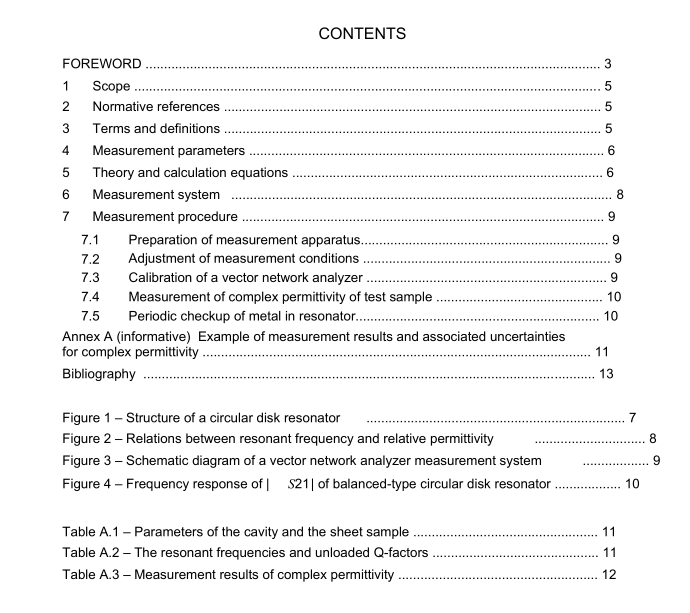IEC 63185 pdf – Measurement of the complex permittivity for low-loss dielectric substrates balanced-type circular disk resonator method

IEC 63185 pdf – Measurement of the complex permittivity for low-loss dielectric substrates balanced-type circular disk resonator method
1 Scope
This document relates to a measurement method for complexpermittivity of a dielectricsubstrates at microwave and millimeter-wave frequencies.This method has been developed to
evaluate the dielectric properties of low-loss materials used in microwave and millimeter-wavecircuits and devices. It uses higher-order modes of a balanced-type circular disk resonator andprovides broadband measurements of dielectric substrates by using one resonator, where the
effect of excitation holes is taken into account accurately on the basis of the mode-matchinganalysis.
In comparison with the conventional method described in IEC 62810 and lEC 61338-1-3,thismethod has the following characteristics:
.the values of the relative permittivitya’ and loss tangent tan3 normal to dielectric platesamples can be measured accurately and non-destructively;
. this method presents broadband measurements by using higher-order modes by one
resonator;
this method is applicable for the measurements on the following condition:- frequency:
10 GHz ≤f≤110 GHz;
– relative permittivity:
1 ≤ Ers 10;
– loss tangent:
10-4 ≤ tano≤10-2.
2Normative references
The following documents are referred to in the text in such a way that some or all of their contentconstitutes requirements of this document. For dated references, only the edition cited applies.
For undatedreferences, the latest edition of the referenced document(including anyamendments) applies.
IEC 61338-1-3:1999, Waveguide type dielectric resonators -Part 1-3:General information andtest conditions – Measurement method of complex relative permittivity for dielectric resonatormaterials at microwave frequency
IEC 62810:2015, Cylindrical cavity method to measure the complex permittivity of low-lossdielectric rods
3 Terms and definitions
No terms and definitions are listed in this document.
Iso and IEC maintain terminological databases for use in standardization at the followingaddresses:
.IEC Electropedia: available at http://www.electropedia.org/
. Iso Online browsing platform: available at http://www.iso.orglobp
-6-
IEC 63185:2020cIEC 2020
4Measurement parameters
The measurement parameters are defined as follows:
er = Er – j &r”
(1)
tano =Er”/Er’
(2)
where a’’ and ar” are the real and imaginary parts of the complex relative permittivity
Er.
5 Theory and calculation equations
A resonator structure used in this method is shown in Figure 1.A thin circular conductor diskwith radius R is sandwiched between a pair of dielectric plate samples to be measured having
the same thickness i and dielectric properties gr’ and tan o.Dielectric samples are sandwichedby two parallel conductor plates. The thickness of the conductor disk is negligibly thin in theanalysis.
The resonator is excited and detected by coaxial lines through excitation holes having radius
and length M.Because only the TMomo modes have the electric field in the center of theresonator,only those modes are selectively excited in the resonator,where the electric fieldcomponents in the resonator are normal to the plate samples for those modes.
r’’ and tanb normal to the dielectric plates are determined from the measured values of theresonant frequencies fo and the unloaded Q-factor Qu for the TMomo mode by solving thefollowing resonant condition derived from the mode-matching analysis, where the exciting holes
are accurately taken into account:
detH(sr’, fo,t,R,a,M) =0
(3)
tano =(1/Ou-1/Oc)(1 + W1/W2)
(4)
where
H
is N x N matrix derived from the boundary conditions;
N
is the number of terms of the series expansions for the mode-matching analysis;
Oc
is the Q-factor due to the conductor loss;
W1 and W2are the electric energies stored in the dielectric region and the excitation hole
region, respectively.
w1 and w2 are calculated from the mode-matching analysis, and
Qc can be approximately by









